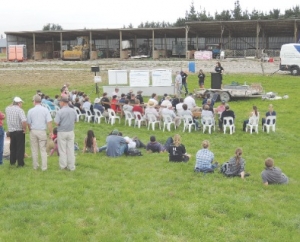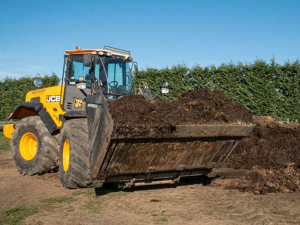“Profit and people are where it starts and stops. I wouldn’t have a business without them. Cows and grass are a means to doing our business but without our people nothing would be sustainable.”
The 14 farm, 13,000-cow dairy business went on to win the award and, not surprisingly, the people theme was to the fore at the on-farm field day earlier this month.
“People don’t buy ‘what’ you do; they buy ‘why’ you do it,” Synlait Farms’ people and performance manager, Josie McKenzie, explained.
That was endorsed by contract milker David Landsdown, who has been with Synlait nine seasons and has, in his own words, “bought into” that principle. “How we communicate with our people has a direct impact on the results we achieve on our farms,” he said.
For example, explaining ‘why’ teatspray must be at the right concentration and applied correctly to all four teats, on every cow, every milking, means they now have a “small to non-existent penicillin mob”.
Sharing farm performance figures with staff also helps explain the ‘why’ behind the ‘how’ and ‘what’ of operations and will generally lead to better execution of tasks. “How many of you talk about your monthly financial results with your team?” Landsdown asked.
In a separate session at the field day, Synlait Farms’ livestock and innovation manager Dave Campbell picked up the people theme in explaining the firm’s In Sync initiative: ‘In’ standing for innovation, ‘Syn’ for Synlait, and C for Continuous improvement through innovation. “I bet you all thought it was a boy band,” he quipped.
The initiative was inspired by the “lean manufacturing” principles born on the car production lines of Henry Ford and later refined by Japanese manufacturers.
“We are turning pasture into high value products. We ‘manufacture’ grass to milk. It’s important to think how we can run lean manufacturing principles… through our business.”
For people to improve processes and innovate, they have to be empowered to change the systems they work in, says Campbell. That means allowing time for them to step back and look at what they’re doing, and making the resources available to see agreed changes made.
Looking off farm for ideas and better ways of doing things, maybe even outside the dairy industry, could help drive innovation, he suggested. “Our mantra is ‘easier, better, faster’.”
When things go wrong or there’s a problem, Synlait’s approach is “root cause analysis”, repeatedly asking why the problem occurred to get to the “root cause” of it. But it’s not an interrogation of individuals: it’s an interrogation of the system or operation using a “fishbone” framework of five Ms: material, method, man, machine, and measurement. The most likely causes are explored first.
As an example, the field day heard how a spike in Cowslip orders on one of Synlait’s farms was identified through group management systems. A check on the farm confirmed a growing lameness problem. Working through possible causes, such as stoney races, backing gate abuse or malfunction, feed etc, it became clear staff pushing the herd was the most likely cause. But the analysis didn’t stop there. Why were some staff pushing the herd? Because they didn’t understand it would cause lameness. Why didn’t they understand that? Because they’d not been trained. Why hadn’t they been trained? Because the timing of a couple of individual’s recruitment meant they’d missed out on the induction process. A brief training session, including an explanation of why cows mustn’t be hurried to the shed, and the root cause of the problem was solved.
















